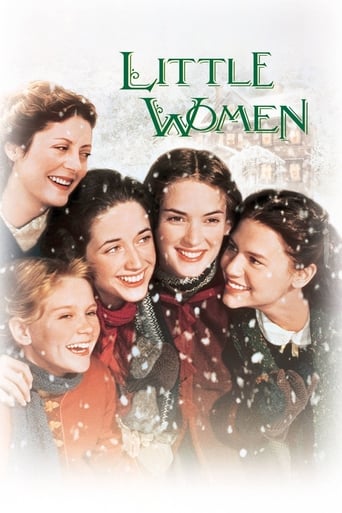

Purely Joyful Movie!
... View MoreWhile it is a pity that the story wasn't told with more visual finesse, this is trivial compared to our real-world problems. It takes a good movie to put that into perspective.
... View MoreIt is interesting even when nothing much happens, which is for most of its 3-hour running time. Read full review
... View MoreIt is encouraging that the film ends so strongly.Otherwise, it wouldn't have been a particularly memorable film
... View MoreSo this is another adaptation of the popular novel "Little Women" for Book Month. I admit that the first version I saw (the 1949 one) was good, but it was a little hard to follow. There was a lot going on and the plot wasn't that focused. I think this movie was better because I understood it more. Then again, I had already seen one version so I was already more familiar with the story. The main story is that Jo is trying to have her novel published.It's funny how the novel she's working on herself is actually called "Little Women", although I assume it's not the same as the actual story happening. I would think a writer would know what it's like to be a writer. The story is mostly slice of life and focuses on various other smaller aspects of the character's lives. I didn't know this had anything to do with Christmas. I should have seen this back in December! At least I'm seeing it now for Book Month. This is a very well acted film with a great cast and feel. ***1/2
... View MoreI saw this with a very good friend on New Year's Eve when it first came out. It is such a wonderful version of the book. As good as the performances are, and they are VERY good (If Claire Danes doesn't bring you to tears, you are a cold one!), the direction and score are even bigger stars here.This movie is beautiful and heartbreaking and life-affirming. I have watched it at least every holiday season since its release. I can't believe that Thomas Newman did not win the Oscar for the score and what fun to see Mary Wickes! Really a great family film.
... View MoreViewers expecting a faithful adaptation of Louisa M. Alcott's novel are likely to be disappointed. However Gillian Armstrong's film is a charming piece - beautifully photographed with a strong sense of seasonal change and how the March family react to such changes. The lighting - both natural and artificial - is soft yet atmospheric, the use of music unobtrusive yet significant. Yet Armstrong does not want to produce a heritage film, prompting viewers to admire the historically accurate sets and costumes; on the contrary, her approach remains strongly character-focused, with the attention paid to nuances of performances. Winona Ryder gives perhaps the best performance of her entire career as Jo; her command of gesture and facial expression is impeccable, especially at those moments of extreme disappointment (for example, when she is told that her first book manuscript is actually no good). A young Kirsten Dunst is both childlike yet mature as Amy; someone who wants to act grown-up yet yearns for her father to be around. Susan Sarandon turns in a winning performance as the matriarch of the family; someone who is incredibly fond of her offspring, yet well aware of their individual faults. The ending might be sentimental, but Armstrong is nonetheless well aware of the economic hardships experienced by the March family as they struggle to survive while their father is away fighting. Definitely one of the best classic adaptations to appear during the Nineties.
... View MoreLittle WomenThe key to raising daughters is ensuring you find a nanny who lost a daughter of her own to raise them.However, the sisters in this drama will have to settle for their own mother's nurturing.Amid the turmoil of the Civil War, the March Sisters - Meg (Trini Alvarado), Jo (Winona Ryder), Beth (Claire Danes), and Amy (Kirsten Dunst/Samantha Mathis) - learn lessons in love from their many suitors (Eric Stoltz, Gabriel Byrne, Christian Bale).As Jo, Meg and Amy pursue their fancies, Beth remains at home with Marmee (Susan Sarandon).The sisters grow so distant that it takes a great loss to bring them back to Massachusetts.Although their lives unfold over years, this fifth and first-rate adaptation of the novel has a holiday spirit that rings throughout its family-centric plot-line.Incidentally, the highlight of the 19th century holiday season was always the annual ugly Christmas petticoat ball.Green Lightvidiotreviews.blogspot.ca
... View More